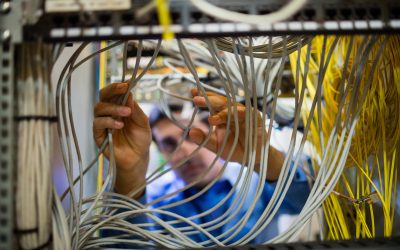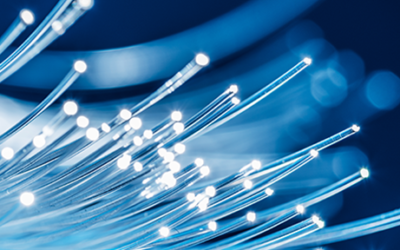Optimizing the Cost per Bit per Meter

Tags: cabling | infrastructure | Networks
It is clear that our insatiable appetite for increased bandwidth, whether over a wired or wireless network, is fed only at the right price. However let’s be clear it is not a choice of price alone, but a decision on what bandwidth or capacity one gets for the price or the ‘cost per bit’ of the solution.
Are you old enough to remember what information technology was like 30 to 40 years ago? A cross-country telephone conversation would often start with “please hurry, I’m calling long distance”. Documents were read over the phone when content was urgent. A “fast” PC connection was one where the ASCII text would display faster than you could read it. Electronic typewriters with memory were hot items! How drastically things have changed, but through the changes one thing has been apparent, optimizing the cost per bit has been a factor in technology adoption whether you have been aware of it or not.
In our opinion, decisions made on high performance infrastructure solutions should be no different. The impact an infrastructure solution has on facilitating a better cost per bit is a simple yet effective measure of the solution’s value.
In both wired and wireless/mobile voice and data networks, disrupting technologies such as 4/5G and WiFi5/6 are having a big effect on the cost structure of transporting a bit over any distance.
These technology changes along with the introduction of IP networks are driving the march to next generation networks. The industry is embracing limitless bandwidth based on the lowest operational cost of transporting a bit a kilometer. we believe only the infrastructurally enabled will survive.
Now that’s a great question to ask – ‘Is your network infrastructurally enabled?’
Network owners need to put in the most coverage, capacity and bandwidth they can justify, knowing it will quickly be consumed. Our imagination of how it will be consumed is only limited by our wallet. The statement “I want it” gets balanced with “can I afford it”. Once the degree of need overcomes the price/affordability hurdle, the purchase is made.
Network designers are seeking to rid network architectures of costly and increasingly unnecessary hierarchies, while optimizing their networks to eliminate delay. Like the virtually free transistors on a microprocessor, latency-free networks and virtually free bits will spur the development of new applications. When transport costs are no longer a barrier to market adoption, the demand for these applications mushroom – resulting in a second order impact of increased capacity demand.
What has this to do with network infrastructures? Well, it is clear that increased bandwidth is emerging in the wide area and access networks, both fixed line and mobile, and at a low cost per bit. The hardware at home, at work and on the move will continue to increase its capability with a reduced cost per bit, and the electronics that link this hardware to the network are increasing in performance with a reduced cost per bit. So surely the trend for network infrastructures is no different. The right choice of infrastructure should take into account it’s ability to optimize the cost per bit of the network.
We believe infrastructure solutions have to have the ability to optimize the cost per bit per meter in the new era of being ‘infrastructurally enabled’. This ability has to be one of the foundations and business drivers for the adoption of any infrastructure technology.

Written by James Donovan
You might also enjoy
FO Connector Contamination – A Constant Threat
Fiber optic communication most commonly works in duplex or multifiber transmission by transmitting light to a receiver in one direction on a fiber and receiving transmitted light back to a second receiver on the second fiber. Most engineers can understand that and...
Why Inspect and Clean Fiber Optic Connectors?
Inspecting and cleaning of fiber optic connectors during installation and when making any patching, is essential. Any contamination on a patch cord connector will be transferred through the coupler to the connector it is mated to. Even when testing fibers with a test...
Cleaning MPOs
MPO connectors should always be inspected with a scope before they are used, be that on a patch cord or a bulkhead. If they need to be cleaned, one-click cleaners are keyed to ensure the tip only fits one way onto the connectors and is able to clean both male and...


